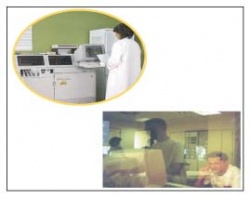Healthcare in Spain
by Dr Eduardo de la Sota
General information concerning the country's healthcare is held at the Instituto Nacional de Estadística (INE).

The INE is a legally independent, administrative, autonomous institution assigned to the Ministry of Economy which task is to regulate statistics activity (demographic and economic censuses, national accounts, demographic and social statistics, and other indicators). The healthcare information includes: Hospital Morbidity Survey, Hospital Indicators Statistics, Death statistics according to cause of death, Collegiate health professionals, survey on Disabilities, Impairments and Health Status, National Health Survey, Health and Sexual Habits Survey, In-patient healthcare institutions, Obligatory Notifiable Diseases and Other aspects related with health.
The Ministry of Health, via the Institute of Health Information, provides information on Health Statistics, Reports and compilations, Standardisation and Coding, Main Figures of the National Health System and Centres and Services of the National Health System (Health Centres, Hospitals, Blood Banks and Transfusion Centres).
Spanish Healthcare Registries - Imaz et al. (2005) from the Carlos III Health Institute, studied the Spanish Healthcare Registries within the 1997-2002 period. 107 healthcare registries were identified, most providing local or regional coverage (71%). Areas with the largest number of registries were related to death statistics (17%) and cancer (16%). 298 publications were retrieved, which analyse data produced by the registries, most of which study the frequency and distribution of the events recorded (58%) and, less frequently to conducting healthcare technology assessment studies (24%). Nonetheless, important areas without any records and improvement elements related to the use of healthcare registries for healthcare technology assessment were detected.
Internet use - A survey conducted by Lorenzo & Mira (2004) among 302 doctors in eight Spanish hospitals revealed that they consider the internet to be a tool that enhances the doctor-patient relationship. New technologies are accelerating the substitution of a paternalistic style by one in which a patient has access to more information and resources. There appears to be a favourable attitude towards seeking a second opinion through the internet, although not towards patient’ chats’.
Sanz Arrufat et al. (2004), from Albacete, analysed 452 hospitals with 100 or more beds; 198 (43.8%) hospital web pages and 52 (11.52%) pharmacy department websites were found. The contents of pharmacy department sites were usually deficient. The authors think that telepharmacy, or pharmaceutical care for outpatients using novel information technologies, remains underdeveloped in Spanish pharmacy departments.
Telemedicine - Gonzalez & Castro (2005) from the University of Santiago, searched the Medline database for publications about telemedicine from 1966 to 2003. The first publication appeared in 1988 and publication output showed a sudden increase starting in 1995, reaching a maximum in 2002 with 21 publications. The mean impact factor of the journals in which the publications appeared was 0.961. Production of telemedicine publications in Spain has followed the same temporal course as observed worldwide. There is an unequal geographical and institutional distribution of publications. The highest production is concentrated in a few institutions and only a small number of authors show steady research activity.
Interestingly, the Bioengineering and Telemedicine Group (Technical University of Madrid), has developed a new model for care of chronically ill patients based on home care supported by remote monitoring technology and telemedicine. The monitored variables include non-invasive blood pressure, blood oxygen saturation, ECG, spirometry and respiratory rate. The telemedicine system includes a home-based patient unit and a management centre that received information from the home units. The chronic care management centre was installed in two hospitals, in Spain (Barcelona) and Belgium (Leuven). The promoters expect this to result in significant cost-savings and a better quality of care.
Healthcare Economic Information - The Catalan Agency for Health Technology Assessment and Research has described economic evaluation studies carried out in Spain and published during the last 20 years. 87 studies were included in the review. According to the methodology, the most frequently used technique was cost-effectiveness analysis. The authors observed that, in most cases, some weaknesses could be pointed out: absence of any objective directly linked to the decision-making process, a non-explicit perspective, no inclusion of indirect costs, or clinical and economical data not currently collected. They conclude that future research studies should improve methodology, increase the dissemination of results and use more sophisticated economic analysis techniques.
Llano et al. (2002) implemented a qualitative analysis of organisational innovations in Spanish public hospitals. They recovered the opinion of CEOs and physicians on the organisational innovations that affected more than one level of health management interventions, and found out that physicians showed increased interest in organisational innovations, while CEOs were ambivalent about their changing role and respective responsibilities. There appeared to be evidence of resistance to change, and probably innovations are needed in the style and characteristics of management structures (composition, functions and responsibilities).
02.08.2006










